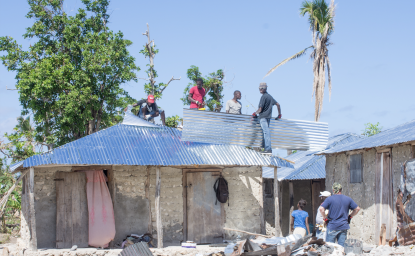Our academic training, our policy offices, our NGOs, and our academic departments reward narrow expertise and single-sector programs. These same communities also penalize interdisciplinary and integrated policy efforts. Yet understanding connections among the social, natural, and physical sciences is crucial both to analyzing some of the most imposing issues of our time and to addressing those issues effectively.
This ninth issue of ECSP Report is about these linkages, especially among non-traditional security issues such as population dynamics, poverty, water, and environmental change.
Pieces by Jane Goodall, Frederick A.B. Meyerson, and Susan Gibbs take different approaches to the ways population dynamics and environmental degradation interact. In the 1980s, Goodall took a flight above the Gombe National Park in Tanzania and saw how refugee in-migration and unsustainable development were destroying the park, a renowned habitat for chimpanzees and a rich variety of other wildlife. Goodall details how The Jane Goodall Institute began to address the livelihoods of people around the park as well as in Central Africa as a whole. Such programs are a prime example of how conservation cannot work in isolation from questions of development and population dynamics.
Meyerson and Gibbs look at population-environment (P-E) from an institutional vantage point and see challenges ahead for this young and promising field. For Meyerson, the future of international megaconferences such as the Johannesburg World Summit on Sustainable Development is in trouble—from "summit fatigue," persistent gaps between rhetorical commitments and actionable resources, and attacks on gains already made at prior conferences such as ICPD in Cairo and the Rio Earth Summit. But such ennui and hostility, he argues, has obscured real global progress in P-E and development action. Gibbs systematically analyzes ongoing changes in public and private giving to P-E programs. While recent foundation losses have affected these programs, Gibbs asserts that population-environment provides a unique, synergistic bounty to donor aims in the developing world.
How poverty might exacerbate national and regional insecurity remains a fertile topic of discussion in some policy circles in the wake of September 11. Indeed, President Bush and U.S. Secretary of State Colin Powell have both stated that poverty in the developing world should be a security concern for the United States. Some analysts, however, feel that the wars in Iraq and Afghanistan have diverted resources and focus away from new efforts against global poverty.
Meanwhile, the debate on poverty as a cause of conflict-—let alone terrorism-—continues to unfold. In "Should Global Poverty Be Considered a U.S. National Security Issue?" commentaries by Vincent Ferraro, Carol Lancaster, Per Pinstrup-Andersen, Jeffrey D. Sachs, and John Sewell provide a rich basis for further discussion of these crucial questions.
From a South Asian perspective, Adil Najam then argues that poverty and good governance are the crucial and long-neglected factors in analyzing the links between environmental stress and violence. For Najam, the focus of most environmental security literature on violent conflict has obscured the far more lethal interactions between poverty and environmental issues.
Finally, Anthony Turton presents the intimate interplay between water and Southern Africa security. In this region of routine interbasin water transfers, increasing water scarcity, and disparate institutional capacities across national boundaries, water has the potential to contribute to regional tensions. Turton stresses that culturally-sensitive capacity building and good governance (based on sound and transparent data) are key to turning potential conflict into cooperation over water.
ECSP Report 9 is broken down by article and is available here for download(PDF).
Related Links




